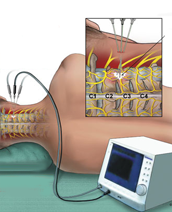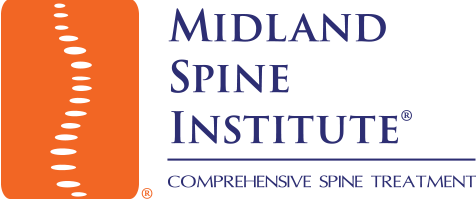Radiofrequency Thermocoagulation (RFTC)
 Radiofrequency thermocoagulation (RTFC) is a treatment utilizing radiowaves and heat to destroy tissue, in our case a nerve, for pain relief. Radiofrequency has also been used for treating fast heartbeats and tumors with great success.
Radiofrequency thermocoagulation (RTFC) is a treatment utilizing radiowaves and heat to destroy tissue, in our case a nerve, for pain relief. Radiofrequency has also been used for treating fast heartbeats and tumors with great success.
Radiofrequency thermocoagulation of the spinal facet joints provides significant pain relief in well-selected patients with facet joint syndrome.
What happens during the actual procedure?
RFTC is an outpatient procedure performed under local anesthesia. Intravenous sedation is used to help the patient relax. During the procedure, radiofrequency waves are transmitted through the tip of a specialized needle placed into the facet joint under x-ray guidance. The heat generated from the needle coagulates the nerve and renders it non-effective for transmitting pain impulses, thus providing pain relief.
After the procedure, the patient will be taken to the recovery room for a brief period of monitoring, and for instructions before discharge.
What are the risks of the procedure?
RFTC is a safe, non-surgical treatment. There are a few possible complications related to RFTC but the risk is low. Your doctor will gladly explain the procedure and the risks to you in detail and answer any questions that you may have.
How will I feel after the injection?
You may experience an increase in pain and/or muscle spam for the first several days following the procedure. Additional pain medications or muscle relaxants may be necessary to help you stay comfortable.
You may notice some swelling and bruising at the needle sites. Using a cold pack will ease the discomfort.
You will be given an instruction sheet on what to do and whom to call should you have any questions or concerns.
Your doctor will arrange a follow-up appointment or phone consult within three to four weeks after the procedure to see how you are doing.
The degree of pain relief varies from person to person. The maximum decrease in pain may take up to three or more weeks to occur. You can eventually expect 50 percent or greater pain relief. Pain relief can last from six to12 months, or longer. The nerves do repair themselves and your pain may return. The procedure can be repeated if the pain returns at a later time.
Why is rehabilitation important after RFTC?
It is important that you start a program of conditioning, strengthening, and range of motion exercises after radiofrequency ablation. Ideally, increased muscle strength around the arthritic joints will make pain relief more prolonged after radiofrequency ablation. With rehabilitation, when the nerves do regenerate, you will not likely experience the same intensity of pain as before the procedure.
You may be prescribed a formal physical therapy program after undergoing the RFTC procedure.

